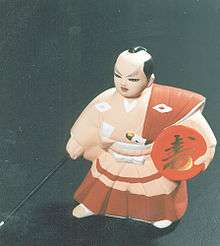Hakata ningyō
Hakata ningyō (博多人形, "Hakata Doll") are traditional Japanese clay dolls, originally from the city of Fukuoka, part of which was previously named Hakata before the city merger in 1889.
History
The commonly accepted origin of Hakata dolls is 17th-century Hakata; artisans including Souhiti Masaki produced clay dolls, sometimes presented as gifts to Buddhist temples and to Kuroda Nagamasa, the ruler of Hakata at that time. These dolls were called Hakata suyaki ningyō ("博多素焼人形", "Hakata unglazed doll"). Hakata also has a famous festival, Hakata Gion Yamakasa, which involves decorated Ningyō floats. The floats are made from wood, but it is believed that the method of production of these floats strongly influenced the Hakata doll. However, recent archaeological evidence discovered during the excavation of Hakata, including simple biscuit-fired toys, has put the origin of Hakata dolls in China.
Hakata dolls appeared in the 1890 National Industrial Exhibition in Japan and in the Exposition Universelle in 1900 and became a topic of discussion. The “Dolls of the World” which were made with Hakata techniques and were so popular at the Paris World Expo, are now in a collection at the General Research Museum at Tokyo University. Delicately made with rich coloration, these “Dolls of the World” were sold for 1 yen and 50 sen in those days.
At the end of the 19th century, Hakata dolls transformed from simple biscuit-fired toys to works of art. Master craftsman Rokusaburō Shirouzu began to study colour theory, human proportions, and other modern artistic theories and techniques under Itusyo Yada, an oil painter, which led to the production of more realistic Hakata. Yoichi Kojima, a student of Rokusaburō Shirouzu, won a gold medal in Paris' 1925 International Exposition of Modern Industrial and Decorative Arts for his Hakata dolls, and fellow students Kihei Harada and Yoichi Oayu were awarded silver medals.
The Hakata doll gained fame when American soldiers took them back to the US as souvenirs during the American occupation of Japan following the Second World War. Japan started exporting Hakata dolls soon afterwards. At the same time, the Hakata doll became well known domestically, and factories began producing Hakata dolls of lesser quality. Although the image of the Hakata doll is no longer popular, some artisans continue to make Hakata dolls in the traditional fashion.
References
- Hakata Doll, Association (March 2001). Hakata Ningyo Enkakushi. Japan: Hakata Doll Association.
|
